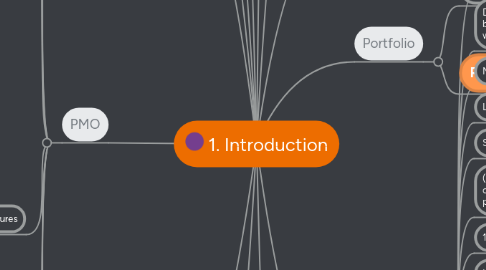
1. Project Management
1.1. Application of knowledge, skills tools and techniques to project activities to meet project requirements
1.2. Accomplished through 47 logically grouped project management processes
1.2.1. 1. Initiating
1.2.2. 2. Planning
1.2.3. 3. Executing
1.2.4. 4. Monitoring & Control
1.2.5. 5. Closing
1.3. Develops & implements plans to achieve specific scope driven by program/portfolio objectives
1.4. Subject to organizational strategies
2. Program
2.1. Program Management
2.1.1. Harmonizes projects, components & controls interdependencies
2.1.2. Application of knowledge, skills, tools & techniques to meet requirements
2.2. Related projects, subprograms & program activities managed in a coordinated way
2.3. Obtain benefits that can't be gotten if handled individually
2.4. May include "outside of scope" elements
2.5. Will ALWAYS have projects
3. PMO
3.1. Project Management Office
3.2. Mngmnt structure that standardizes project-related governance processes
3.3. Facilitates sharing resources, methodology, tools & techniques
3.4. Provide PM support or direct mngmnt
3.4.1. Manage shared resources
3.4.2. Identify PM methodology & standards
3.4.3. Coach & mentor
3.4.4. Develop policies, procedures
3.4.5. Coordinate communication
3.5. Structures
3.5.1. Supportive
3.5.1.1. Project Repository
3.5.1.2. Consultative role
3.5.1.3. Supply templates
3.5.1.4. Best Practices
3.5.1.5. Training
3.5.1.6. Access to info
3.5.1.7. Lessons learnt
3.5.1.8. LOW control
3.5.2. Controlling
3.5.2.1. Support
3.5.2.2. Requires compliance
3.5.2.2.1. Adopt frameworks or methodologies
3.5.2.3. Use templates
3.5.2.4. Conformance to governance
3.5.2.5. MODERATE control
3.5.3. Directive
3.5.3.1. Take control of projects
3.5.3.2. Direct mngmnt
3.5.3.3. HIGH control
3.6. Integrates data and info
3.7. Liaison between portfolios and measurement systems
3.8. e.g. balance scorecard
3.9. Integral stakeholder
4. PM VS PMO
4.1. PM
4.1.1. Specified project objectives
4.1.2. Project level
4.2. PMO
4.2.1. Major program scope changes (opportunities)
4.2.2. Enterprise level
5. Operations Management
5.1. Oversee, direct, control business operations
5.2. Outside formal PM
5.3. Use optimum resources
5.4. Transform input into output
6. PBO's
6.1. Project Based Organizations
6.1.1. Organizational forms
6.1.2. Create temporary systems to work
6.1.3. Created by diff. organizations
6.1.4. (-) Hierarchy & bureaucracy
6.1.5. No functional approach
7. Good Practices
7.1. General agreeement that the application of knowledge, skills, tools & techniques can enhance chances of success
7.2. No golden rules
8. Portfolio
8.1. Projects, programs, subportfolios & operations as group to reach strategic objectives
8.1.1. May not be interdependent or related
8.2. Portfolio Management
8.2.1. Aligns with organizational strategies, selects right programs or projects, prioritizing work & providing resources while achieving strategic objectives
8.2.2. Goal: Maximize value of portfolio with examinations of components
9. Project
9.1. Temporary endeavour to create a unique product, service or result
9.2. Definite beginning and end (objectives (can't be) met, project need disappeared, client wants to end)
9.3. Not necessarily short-term
9.4. Lasting outcome <improvements>
9.5. Social, economic or environmental impact
9.6. (in)tangible results <products, enhancements or components> <service or capability to perform>
9.7. 1 or > individuals
9.8. Identify requirements
9.9. Address needs, concerns & expectations
9.10. Set up, maintain & carry out communications
9.11. Balancing competing project constraints
9.11.1. Scope, quality, schedule, budget, resources, risks
9.12. May be or not part of a program
9.12.1. If part of a program, common outcome or collective capability
9.12.2. If part of a portfolio, shared client, seller, tech or resource
9.13. Means of (ind)directly achieving objectives within and organization's strategic plan
9.14. Authorized as a result of:
9.14.1. Market demand
9.14.2. Strategic opportunity/business need
9.14.3. Social need
9.14.4. Environmental consideration
9.14.5. Customer request
9.14.6. Tech advance
9.14.7. Legal
9.15. Intersect with operations
9.15.1. At closeout phases
9.15.2. Developing new product
9.15.3. Improving operations
9.15.4. End of product life cycle
10. OPM
10.1. Organizational Project Management
10.2. Strategy execution framework using project, program & portfolio mngmnt & organizational practices for better performance, results & competitive advantage
10.3. Advances organizational capability
10.4. Links project, program & portfolio management principles & practices with organizational enablers (structural, cultural, tech & HR practices) to support strategic goals
11. Business Value
11.1. Entire value of business
11.2. Sum of (in)tangible elements
11.2.1. $ assets
11.2.2. Equity
11.2.3. Brand recognition
11.2.4. Good will
11.3. Created through effective mngmnt
11.4. Comprehensive strategy and planning
11.4.1. Mission & vision
12. PM
12.1. Project Manager
12.1.1. Lead team responsible for achieving project objectives
12.1.2. Link between strategy & team
12.1.3. Satisfies needs from:
12.1.3.1. Task
12.1.3.2. Team
12.1.3.3. Individual
12.1.4. Skills
12.1.4.1. Knowledge
12.1.4.2. Performance
12.1.4.3. Personal
12.1.4.4. Ethical, interpersonal & conceptual
12.1.4.5. Leadership
12.1.4.6. Teambuilding
12.1.4.7. Motivation
12.1.4.8. Communication
12.1.4.9. Influencing
12.1.4.10. Decision making
12.1.4.11. Negotiation
12.1.4.12. Trust building
12.1.4.13. Conflict mngmnt
12.1.4.14. Coaching
